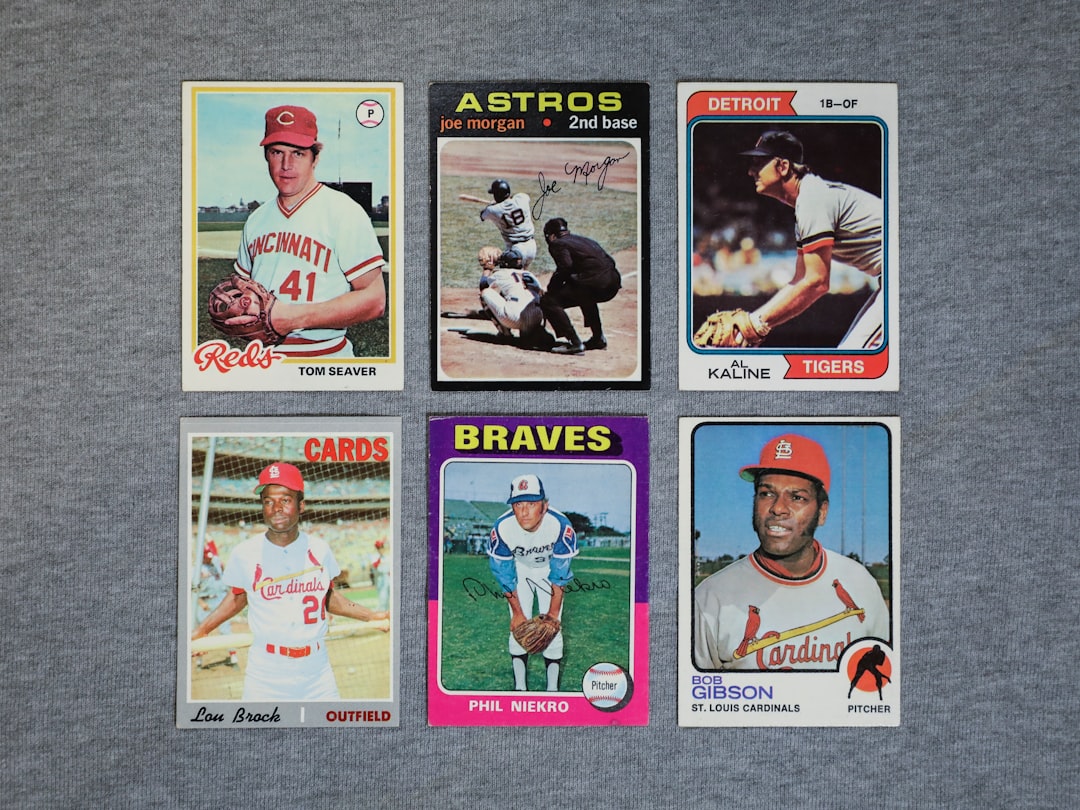

Engage prospects with a scan and streamline customer engagement with FREE QR code marketing tools by Sona – no strings attached!
Create a Free QR CodeFree consultation

No commitment

Engage prospects with a scan and streamline customer engagement with FREE QR code marketing tools by Sona – no strings attached!
Create a Free QR CodeFree consultation

No commitment
Baseball card retailers are navigating a transformative era where digital integration is redefining how collectors buy, sell, and engage with trading cards. Traditionally rooted in in-person browsing and local shops, the landscape now features a blend of online platforms, social media communities, and technology-driven retail experiences. Yet many retailers still rely heavily on printed promotions, in-store signage, and manual processes that often fail to fully capture lead interest and overlook high-value prospects who interact physically but remain digitally anonymous.
Today's buyers expect instant access to information about sports card values, authenticity, and exclusive offerings without the hassle of lengthy or outdated manual processes. When potential customers browse rare cards or interact with event promotions but do not fill out a form or provide contact information, retailers risk missing valuable leads and let demo-level interest slip away untracked. This demand for immediacy and engagement is sparking innovation across the industry, with QR code baseball cards and NFC technology leading the charge, addressing the urgent need to connect offline collector intent with actionable digital insights.
By leveraging QR codes in marketing, baseball card retailers can tie offline interactions to online journeys, gain real-time visibility into previously anonymous visitor interest, and create data-enriched opportunities for remarketing, upselling, and nurturing ongoing collector engagement. The playbook is simple: place scannable codes wherever curiosity peaks, route scanners to compelling digital experiences, and capture the data needed to follow up with relevance. The result is a connected retail engine that learns from every interaction and compounds growth over time.

Physical retail environments have long presented barriers to deeply understanding who your collectors are, often resulting in missed follow-ups and untracked high-value interest when visitors walk out without registering or engaging digitally. QR codes bridge this gap between physical memorabilia and digital engagement, empowering retailers to capture leads who would not have otherwise filled out a form or joined a mailing list. When implemented with intent, QR codes do more than invite a scan; they create a measurable micro-conversion that can be tracked, segmented, and nurtured.
The key is to design your QR strategy around known friction points in the collector journey. Replace paper sign-up forms, static flyers, and manual list-building with QR-driven flows that remove buyer friction. Layer in analytics so that each scan updates your CRM and informs your messaging. Think of QR codes as dynamic connectors between your showcases, events, and promotions, and the digital experiences that push a collector to take the next step.
Modern QR platforms such as Sona QR’s product overview enrich records as soon as a scan is captured, allowing retailers to map and re-engage overlooked opportunities and keep campaigns aligned throughout the collector journey. Over time, the data reveals which displays, events, or offers generate the highest-value leads, so you can double down on what works and retire what does not.

A major challenge in baseball card retailing has been bridging the gap between lively in-person experiences and actionable digital leads. Traditionally, valuable prospects remain unknown if they never submit details, leaving many retailers blindsided when high-intent shoppers browse but stay anonymous. This missed connection leads to lost opportunities, especially for limited releases or high-value cards where swift follow-up is critical and timing is everything.
QR codes erase this gap by turning every physical interaction into a digital doorway. Whether a collector is considering a raw vintage card, watching a box break, or flipping through an in-store catalog, a quick scan can route them to authenticity checks, waitlists, valuation content, or membership perks. Dynamic QR codes add another layer of agility since you can update destinations without reprinting, keeping campaigns aligned with inventory shifts and market trends. Scanning analytics reveal which touchpoints generate engagement so teams can refine placement, CTAs, and offers for maximum impact. Many tech-forward card shops are demonstrating this shift.
The result is smarter, more cost-effective marketing and sales efforts, with fewer lost prospects and improved messaging alignment across all touchpoints. Instead of relying on chance conversations, retailers can engage with precision, build richer profiles of their audience, and nurture interest into action.

One ongoing frustration for retailers is not knowing which collectors interact with which products or campaigns, making it hard to prioritize follow-ups or personalize offers. QR codes offer a flexible solution by enabling a range of formats tailored to distinct collector needs. Selecting the right format ensures your scanner lands on a page that matches intent and accelerates the next step.
With Sona QR, you can generate all of these formats, manage them centrally, and switch destinations as your campaigns evolve. For most baseball card retailers, dynamic web links and form-driven codes deliver the highest value because they capture intent signals and enable follow-up without additional steps.

Growth in baseball card retailing is often stunted not by lack of interest, but by failure to recognize and capture it early in the collector journey. Missed touchpoints on packaging, event signage, or mailers mean missed signals from buyers ready to act or move deeper into the funnel. QR codes unlock these opportunities by converting moments of curiosity into measurable actions, creating an always-on pipeline of prospects that you can segment and nurture.
Start by mapping your most trafficked surfaces and moments. Consider where customers pause, ask questions, or hesitate, and place a code with a benefit-focused CTA exactly there. Each scan becomes a signal of intent that you can attribute to a channel, location, and product category.
Prioritizing QR deployment across these moments helps retailers capitalize on genuine intent and uncover leads who would otherwise remain invisible. As you collect scan data, you will be able to identify the placements that produce the highest-value audiences and shift resources accordingly.

Real-world engagement data repeatedly highlights the challenge of verifying authenticity and maintaining trust around rare or high-value cards. Counterfeit concerns, missed upsell opportunities, and fragmented communication all hinder loyalty and sales. QR codes address these pain points with experiences that are instantly accessible and easy to track.
Start with use cases that align to your highest-value outcomes. If you run showcases with vintage inventory, authentication and education matter most. If you rely on live breaks and community engagement, RSVP and post-purchase follow-up become critical. Each use case should be paired with a clear destination, a specific CTA, and a plan for follow-up.
These use cases transform what were once disconnected, hard-to-measure interactions into visible steps along the collector journey. Over time, your data will show which use cases move people from casual interest to purchase, so you can continuously refine your strategy.
The inability to recognize and segment high-intent but previously anonymous collectors is a persistent pain point. QR initiatives solve this by turning fleeting engagement into persistent signals that can be used for retargeting, lead scoring, and tailored offers. When every display, event, and mailer uses its own code, you gain automatic segmentation by channel, placement, and purpose.
Begin by defining the segments that matter for your business. For baseball card retailers, useful distinctions include vintage aficionados versus modern hobbyists, raw card browsers versus graded-only buyers, local show attendees versus online-only shoppers, and investors versus casual collectors. With that map in hand, assign codes to each stage and location so the data tells you exactly who is engaging and why.
Retailers who build these high-fidelity audiences can close the gaps that traditional outreach leaves open. By matching messaging to behavior, conversion rates climb and media spend becomes more efficient since you are speaking to the right collector at the right moment.
Disconnected or inconsistent campaigns often leave prospects confused or disengaged, undermining both marketing spend and customer trust. QR codes offer a unifying thread that connects tactics across print, in-person, and digital environments, ensuring a consistent, stage-matched message as collectors move from awareness to consideration to purchase. The practical payoff is better attribution, cleaner hand-offs between channels, and more opportunities to personalize.
Think of QR codes as the bridge between every offline impression and your digital conversion engine. With centralized management, you can coordinate placements across catalogs, showcases, livestreams, and direct mail while keeping offers in sync and destinations up to date.
Centralized code management and CRM syncing keep all channels speaking the same language. A platform like Sona QR helps you monitor scan performance across media, route data to your CRM, and update destinations instantly when inventory or promotions shift.
Many retailers find that strategic intent such as converting demo interest or surfacing upsell-ready customers falls through the cracks without structure. This checklist provides a practical framework to launch and manage QR campaigns that align with business goals and minimize missed opportunities. Use it to standardize your approach, measure success, and refine continuously.
Before you begin, identify one or two high-impact use cases to prove value quickly. Keep the experience simple, the CTA clear, and the follow-up automated. As results come in, expand placements and add segmentation.
Decide on a primary outcome that connects to revenue or high-value engagement. For baseball card retailers, examples include building a waitlist for a vintage showcase, collecting auction RSVPs at a card show, or capturing appraisal requests from sellers considering consignment.
Select the format that best fits the task. Static codes are fine for fixed destinations like store hours or a catalog PDF, but most retail growth use cases benefit from dynamic QR codes that are editable and trackable.
Design is not decoration; it is instruction. Your QR needs to be visible, scannable, and paired with a benefit-driven CTA. Test scanning from different angles, distances, and lighting conditions before deploying.
Roll out your QR codes where attention is highest and intent is clearest. Start with a few placements, measure performance, and then scale to more surfaces as you see results.
Measurement is what turns a QR code from a link into a growth tool. Monitor scan data, map conversions, and adjust in real time as you learn which touchpoints succeed.
A persistent source of friction for baseball card retailers is the inability to trace how offline actions lead to pipeline or purchases. Without transparent analytics, many high-intent interactions go unrecognized and unmonetized. If you can only see that a poster was printed, not whether it prompted action, you are likely underserving serious buyers and overinvesting in channels that do not convert. For measurement frameworks, review Sona’s guide to offline attribution.
The fix is to treat every QR scan as a trackable touchpoint and to connect those touchpoints to outcomes such as list growth, appointment bookings, bids placed, and sales closed. When analytics flow into your CRM and ad platforms, your team can act in real time instead of guessing after the fact.
Sona QR and Sona.com together deliver this end-to-end visibility: Sona QR captures real-world engagement and Sona.com turns that engagement into revenue insights. With unified analytics, you can prove impact, optimize spend, and prioritize the actions that drive growth.
Despite initial adoption, some retailers stall because they treat every collector the same or fail to tune follow-up. A thoughtful strategy that blends placement, messaging, and automation will convert scan interest into lasting relationships and incremental sales. The goal is to make every scan immediately useful to the collector and immediately informative for your team.
Prioritize tips that align with your most common media types and buyer flows. For many shops, that means display cases, event materials, direct mailers, receipts, and shipping inserts. Tailor your CTAs and destinations accordingly.
Start creating QR codes for free: Start creating QR codes for free. Set up a few high-impact placements, connect them to your CRM, and watch as once-invisible interest becomes trackable signals you can act on.
Many retailers discover that creative QR deployments can turn formerly anonymous or disengaged customers into active, high-value fans when they address specific pain points with targeted experiences. Small tweaks to placement or messaging can produce outsized gains, especially in stores where showcases and events naturally draw attention.
Draw inspiration from common scenarios in the hobby. Consider the information a collector wants at the exact moment of curiosity, and offer it via a scan with minimal friction. The faster you satisfy the question, the more likely you are to guide the next action.
These approaches solve familiar problems: anonymous showroom traffic, weak post-purchase follow-up, and disconnected event experiences. Each example transforms passive interest into trackable engagement, paving the way for targeted outreach and repeat sales.
Retailers sometimes invest in QR solutions only to see lackluster scan rates or poor follow-through. Common missteps include generic CTAs, poor placement on reflective glass or cluttered backgrounds, and stale destinations that do not match current inventory. Avoiding these pitfalls can be the difference between a novelty that fades and a capability that compounds growth.
A robust QR strategy is iterative. Pair every launch with a plan to measure, learn, and adjust. Make it easy on yourself by standardizing code creation, documentation, and analytics so your team can scale what works without confusion.
QR codes have emerged as a crucial mechanism for baseball card retailers hoping to move beyond the limitations of manual engagement and fragmented lead capture. By meeting persistent challenges such as unknown showroom traffic, unconverted demo interest, and inconsistent campaign messaging head on, QR solutions knit together every stage of the collector journey. From tackling the risk of counterfeit cards with digital authentication to recognizing upsell signals in real time, a thoughtful QR strategy ensures that every interaction is an opportunity waiting to be realized.
When retailers adopt an integrated, data-informed approach to QR code deployment, they transform one-time browsers into lasting relationships and replace ad hoc marketing with intentional, insights-driven outreach. In a market where missing a single collector can mean a lost sale or missing an upsell window means overlooked growth, these strategies unlock a competitive edge that resonates throughout the sports memorabilia industry.
QR codes have transformed baseball card retailers from static displays into dynamic, measurable engagement channels. Whether it’s attracting new collectors, enhancing in-store and online experiences, or deepening customer loyalty, QR codes replace guesswork with instant, mobile-friendly interactions that capture real-time data—turning every card and display into a powerful sales driver. Imagine knowing which promotions or exclusive content truly captivate your audience—and being able to optimize them instantly.
With Sona QR, you can create dynamic, trackable QR codes in seconds, update campaigns without costly reprints, and connect every scan directly to revenue. This means you can effortlessly track which cards spark the most interest, retarget engaged customers with tailored offers, and prove the ROI of your marketing efforts. Start for free with Sona QR today and turn every scan into a conversation, a loyal customer, or a closed deal.
Baseball cards are available through a blend of online platforms, social media communities, and technology-driven retail experiences that complement traditional local shops.
QR codes connect physical cards and promotions to digital content such as authentication, valuation tools, exclusive offers, and event registrations, enabling real-time engagement and follow-up.
Vintage baseball cards can be found through online marketplaces, specialized showcases, and retailers who use QR codes to promote limited releases and private viewing lists.
Retailers are using QR codes and NFC technology to bridge offline interactions with digital insights, enabling dynamic content, real-time tracking, and automated customer engagement.
Use QR codes linked to instant valuation tools, price guides, and investment advice available at physical displays or online platforms to quickly assess card values.
Many tech-forward retailers provide authentication by linking QR codes on cards to digital certificates verifying grading, provenance, and sales history.
Retailers use QR codes to route sellers to consignment intake forms and trade evaluation requests that capture card details and contact information for follow-up.
NFC technology enhances collector engagement by enabling quick, contactless access to authentication, valuation, and exclusive content without scanning QR codes.
Limited edition and autographed cards are often promoted through QR code-enabled campaigns, vintage showcases, direct mailers, and exclusive event lists.
Retailers provide QR codes linking to care instructions, storage tips, and grading education to help collectors properly maintain their cards.
Use Sona QR's trackable codes to improve customer acquisition and engagement today.
Create Your FREE Trackable QR Code in SecondsJoin results-focused teams combining Sona Platform automation with advanced Google Ads strategies to scale lead generation

Connect your existing CRM

Free Account Enrichment

No setup fees
No commitment required

Free consultation

Get a custom Google Ads roadmap for your business






Launch campaigns that generate qualified leads in 30 days or less.
